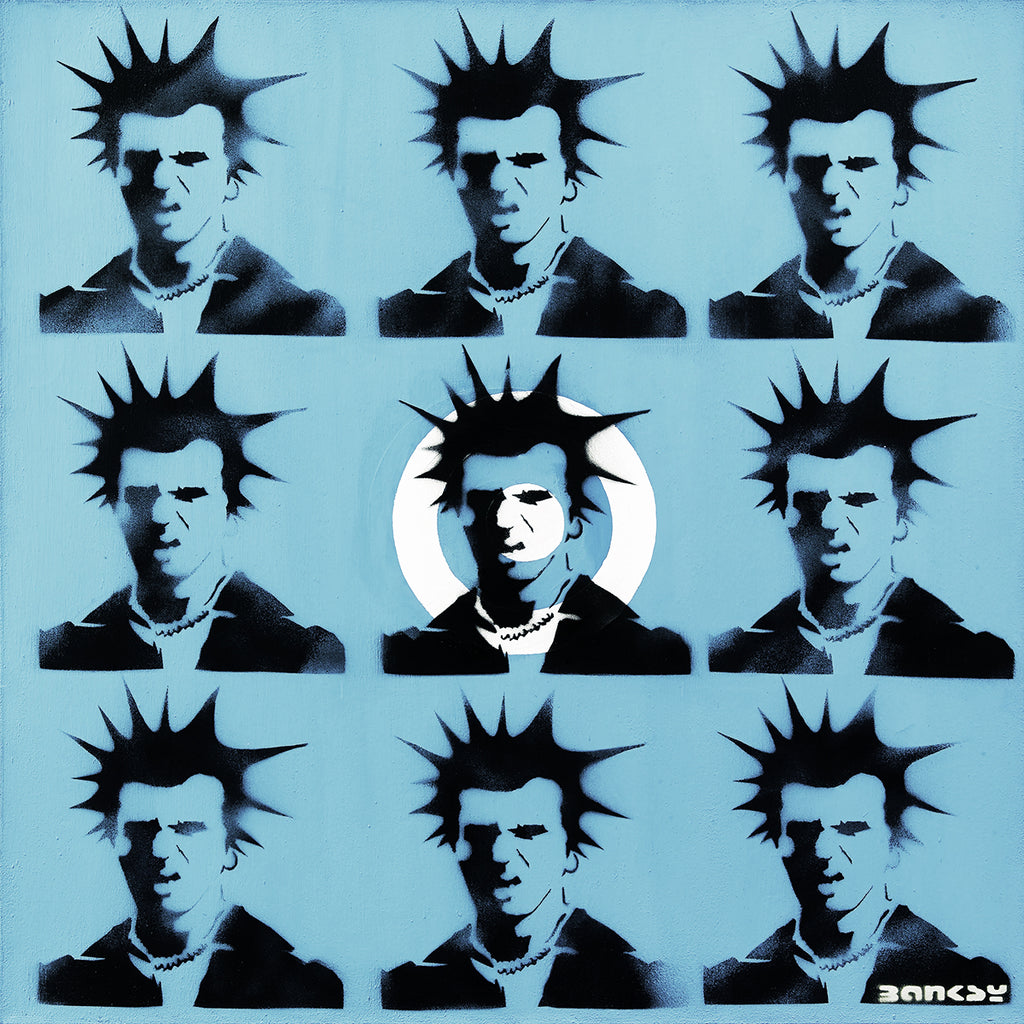
Sid Vicious
Known for his on-stage antics as much as his sadly turbulent personal life, Sid Vicious came to typify the punk subculture of the 1970s and 80s. Vicious was the posterboy for the anti-establishment movement and his image, marginalised look and drug addiction came to embody not just Vicious and his band but the wider musicians and artists of the time who were equally as opposed to convention. Politically speaking, punk ideologies are mostly concerned with individual freedom and anti-establishment views. Common punk viewpoints include individual liberty, anti-authoritarianism, a DIY ethic, non-conformity, anti-corporatism, anti-government, direct action and not "selling out"
Banksy’s early, painted circa 2000, interpretation of the famous punk is characterised by a bright colour palette that differentiates it from many other works by Banksy. A further version was produced in the same year and features a white line of sight target seemingly aiming at the punk.
Deeply influenced by Andy Warhol’s work, the nine portraits of Vicious in grid formation makes one think of Warhol's icons such as Marilyn Monroe in Marilyn Diptych and Elvis Presley in Elvis 21 Times and Eight Elvises. Warhol in his use of repetition questions both consumerism and mass production, Banksy pushes this concept further combining pop art with counter-culture. What’s more we witness Banksy pay homage to Warhol (much like in his Tesco Soup Cans series) and play with the iconography and concepts of pop art. 
Turf War
Banksy’s Turf War is inspired by an original portrait of Churchill, known as The Roaring Lion, that was taken by Armenian-Canadian photographer Yousuf Karsh in the chamber of the Speaker of the House of Commons in the Canadian Parliament in Ottawa on December 30, 1941, after Churchill delivered a speech on World War II. In a 2002 BBC poll Winston Churchill was voted the Greatest Briton, mainly for his efforts during the Second World War, however crticism which can often be ignored involves his approach to race and colonialism, Here we see Banksy refusing to venerate churchill as he converts a symbol of the establishment through the anti-authortarian and rebellious Mohican hairstyle associated with the punk movement of the 70’s and 80’s.
A seminal work, Turf War was the centrepiece of the artist’s bold and infamous second solo exhibition, which marked his breakthrough, taking the British art scene by storm in July 2003. Showing the anti-establishment wit and satirical humour integral to the very best of Banksy’s output, the work depicts a portrait of Sir Winston Churchill on a huge scale (254 x 254 cm). Churchill is a figure revered by many for his successful premiership that played a part in Britain’s triumph in the Second World War and criticised by others for his strong monarchist and imperialist views. While clearly referencing Yousuf Karsh’s portrait of Churchill that once became emblematic of British defiance against fascism, Turf War – executed on canvas in Banksy’s acclaimed stencilled style – subverts the pathos of the original image by portraying the British political icon with a green mohican made from turfed grass. Born out of Banksy’s rebellious visual language, this irreverent depiction continues to hijack the physical and conceptual spaces that, in Banksy’s own words, do not belong to him, unsettling the social order upheld by an elite class.
Through non-conformist motifs, repurposing of cultural imagery and values Banksy uses punk as a vehicle to deliver his anti-establishment views whilst criticising both punk in and unto itself and the institutions that once shackled the movement. For more information on our Banksy original paintings for sale or to buy a Banksy print, contact Andipa via +44 (0)20 7581 1244.